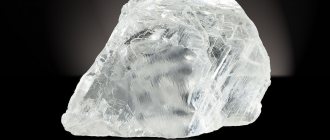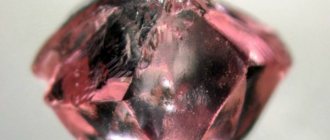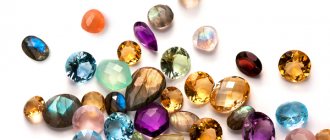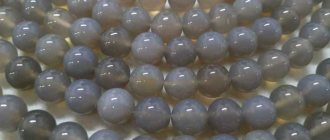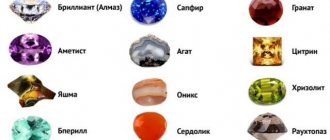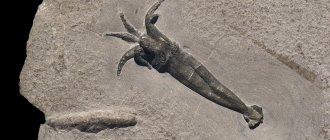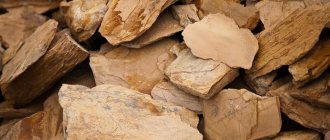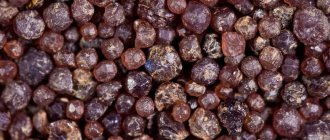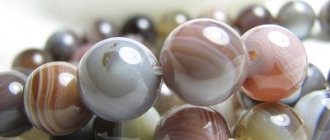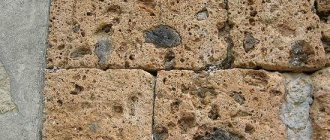A yellow diamond is a diamond that differs from the usual clear diamond in color. About 90% of natural diamonds, called “yellow,” have a slight yellowish tint, and only 10% of the remaining stones have a clear yellow color. For such truly unique crystals, a classification group was identified - fantasy.
There are actually a number of “names” that yellow fancy diamonds have come to be called over time. The smallest number of yellow stones are called canary stones, while others, simpler ones, are called ordinary stones. A canary stone has an intense, bright yellow color, while a regular diamond has a faint yellow tint.
WHERE DO YELLOW DIAMONDS COME FROM?
Diamonds are created by a powerful combination of pressure and high temperatures. Under such conditions, over thousands of years, the sparkling, hardest stone on earth is born from black, brittle graphite.
The yellow color comes from nitrogen atoms or (very rarely) nickel and lithium. The color (intensity and shade of color) of the gem will depend on how many nitrogen atoms and how they are arranged.
In Russia, yellow diamonds are mined in the Republic of Sakha-Yakutia and the Krasnoyarsk Territory.
World mining of yellow gems is carried out in the following countries:
- Australia;
- Tanzania;
- Brazil;
- SOUTH AFRICA;
- Botswana;
- Namibia, etc.
Mining of yellow gems The world leader in diamond mining (by price of nuggets) is Botswana. Russia takes an honorable 2nd place.
Origin
Reference. Scientists still haven't decided how many thousands or millions of years it takes nature to create colored diamonds. But mineralogists claim that special conditions are needed for the birth of the king of crystals.
Deep in the earth's crust there must be not only high temperature, but also a certain pressure. In such a furnace, a diamond is produced from carbon and nitrogen. And the addition of ferrous minerals gives the indestructible stone a lemon color.
PROPERTIES OF YELLOW DIAMONDS
Strictly speaking, there are two types of yellow diamonds. Yellow diamonds are classified as fancy or cape stones. Yellow gems are divided into these two types by their price, composition, and impurities.
The properties of a diamond do not change no matter where it is located.
- highest (10 on the Mohs scale) hardness. Not to be confused with fragility, these are different things;
- thermal conductivity 900-2300 W/(m K) - the highest among solids;
- will burn in air at T 850–1000 °C;
- luminescence: all diamonds glow under cathode and X-ray radiation, and some of them glow under UV radiation.
How important is cut?
When it comes to colored diamonds, cut is not as important as it is for white diamonds.
While regular colorless diamonds are cut to maximize their brilliance, colored diamonds are cut to maximize their color.
This is why the ideal cut proportions used for white diamonds do not apply to yellow ones.
For this reason, when choosing, you should first look at the color characteristics.
Once you've narrowed down your options, you can use cut as a secondary attribute to help you make your final purchasing decision.
CLASSIFICATION OF YELLOW NUGGETS
There are strict 4 Cs for diamonds:
- stone weight;
- color;
- purity;
- cut.
Any diamond that has a certificate has a grade for each item. The price will depend on the total assessment.
Carats
The weight of diamonds is measured in carats with an accuracy of 0.01 carats. 1 carat is equal to 0.2 g (200 mg). Stones over 15 carats are rare, stones over 100 carats are a happy event in the diamond world.
In ancient times, the weight of a gemstone was measured by ... the number of carob pods. These pods weigh exactly 0.2 g when mature. Weighing the gem with a handful of pods was not difficult.
Carat
Purity
Russian specifications describe inclusions in detail:
- their number;
- location;
- volume, etc.
We recommend: HERKIMER DIAMOND
which affect the purity of the stone.
Diamond purity groups are distributed as follows:
- 1 (IF) - without external and internal defects;
- 12 (I3) for diamonds > 0.29 carats. Numerous defects of various types.
- 9 (I3) for diamonds < 0.29 carats. The characteristics of the defects are the same as for 12 (I3).
Color
Yellow fancy stones are assigned the following colors:
- light yellow;
- yellow;
- intense yellow;
- thick yellow.
depending on the hue and color saturation.
Colloquially, the colors of precious pieces of minerals are called:
- canary;
- pear;
- corn;
- citric.
Russian experts have a special sample stone for testing: to compare it with the color of the diamond being examined. If the color is richer than the sample, it is a specimen of fancy coloring.
Intensity
This is where the matter is complex and not amenable to instrumental analysis. Well, tell me, can you distinguish by eye a “slight” yellow tint from a “barely perceptible yellow” or even a “slight yellow”? But gemologists can. And that's not it.
Color intensity of gems
Experts estimate the color intensity of gems with different numbers of edges and different weights differently:
- For example, the shade of a small class 4 crystal will be more saturated than the shade of a stone of the same class, but weighing 0.3 carats or more.
- According to the GIA systematization, there are 9 gradations of color intensity for fancy diamonds - from very weak to bright fancy.
Cut
A cutter always balances between two goals:
- Quality of cut.
- Obtaining the greatest weight of diamond from a diamond.
During the cutting process, nuggets lose a lot of weight - sometimes almost half. Now - nostalgia.
During the Soviet era, our cutters had several serious advantages over the “foreign” ones. This:
- Possibility of choosing the best Yakut diamonds. A large amount of yellow stones are mined in Yakutia.
- The cutter's salary depended on the accuracy of the specifications, so the main thing was to get the perfect diamond without suffering from weight loss. Abroad, it was often necessary to sacrifice the quality of cutting in order to preserve the mass as much as possible.
- The diamond industry in the Union was “numbered”—secret. Therefore, the “draconian” requirements were fulfilled unconditionally. It is possible that without secrecy, our diamonds would be no better than our cars (remember the Soviet Zhiguli).
GIA experts say that the Soviet diamond will be distinguished from any other by the quality of its cut. Almost only Soviet diamonds can boast of the absence of polishing on the edges, which is nothing more than “cleaning up” areas of incorrect processing.
There were 7 jewelry factories in the Union, now there are a hundred or one and a half small firms. Each owner himself determines how the gem should turn out. And benefit, not quality, comes first here.
“Before perestroika, Russians cut diamonds like a textbook and did not pay attention to the yield of good ones. Russian cutting was the best in the world.” Harry Galloway (Australia).
Diamond mining in Yakutia
There are different cuts, each with its own advantages and disadvantages:
| Round | brilliant cut | A classically cut diamond sparkles and shines like a star. |
| Square | princess cut | The “purer” the gem, the more radiant it is |
| Marquise | marquise cut | Relatively more expensive since more diamond mass is lost during processing |
| Rectangle | emerald cut | All the flaws are in full view. Therefore, the stone is selected carefully |
| Oval | oval cut | The secret - visually lengthens your fingers |
| Cushion | cushion brilliant cut | In the Baroque era, diamonds were cut this way. Wear them by candlelight - in their light the decoration sparkles simply fabulous! |
| heart | heart shape | The cut is close to a pear |
| Tear, drop, pear | pear shape | Combines the advantages of oval and marquise cuts |
| Baguette | baguet | Baguettes are good if they are colorless, otherwise the color will “smear” the shine |
| Triangle (trilliant, trine) | trillion cut | Diamond cut modification. |
We recommend: LARIMAR - the legacy of Atlantis, the legend of the Dominican Republic
Characteristics, mining and production of diamonds
This beautiful mineral received its name due to one of its inherent qualities - extraordinary hardness. Diamond also has a number of other characteristics that make it exceptional.
Some of the amazing properties of diamond:
- high density of stone, making its processing quite expensive and difficult;
the ability to withstand the action of even the strongest acids in high concentrations;- combustion at a temperature of 720 degrees, and at 1200 degrees (under atmospheric pressure) - transformation into graphite;
- simplicity of composition compared to other minerals (pure carbon).
Diamond mining is carried out on almost all continents. Most deposits are concentrated where there is a horizontal occurrence of rock layers. The deposits themselves can be indigenous (or primary), that is, formed on igneous rocks and not subject to destruction or transformation. When the primary deposits are destroyed, alluvial (secondary) deposits appear.
The diamond mining process itself is quite expensive and labor-intensive. Almost until the 19th century, it was reduced to raking river sand with a shovel and washing it in special trays.
Modern mining is carried out in several stages, which include:
- the exploration stage, during which the search for new deposits and the extraction of the first specimens of precious stones are carried out;
the infrastructure stage, at which the preparation of the site for the development of the deposit is carried out, the purchase of equipment and the organization of accommodation for personnel involved in the process of mining and processing the mineral;- factory stage (construction of a processing plant), accompanied by primary diamond processing;
- the mining stage, at which, after primary and secondary grinding of ore, its sifting and sorting, the resulting valuable material is sent to the sorting shop. Once the sorting process is completed, the stones are put up for sale.
When separating diamonds from waste rock, various methods are used, including fatty, X-ray, suspension and electromagnetic installations. The principle of their operation is based on the detection and cutting of precious stones from the main mass for their subsequent processing.
The main diamond mining is carried out in Russia (Yakutia, Perm and Arkhangelsk regions), followed by Australia and the Republic of Botswana. At the same time, the yellow diamond is found both in Australian deposits and in Yakutia. Such minerals are distinguished by a special crystalline shape, curved-rounded.
Yellow diamonds themselves are not uncommon. However, intensely colored stones are highly valued. A yellow mineral of a calm, traditional color, the color of which is given by minor nitrogen impurities, will be designated “cape”.
The bright yellow, fancy color may otherwise be called "canary" (a lemon tint) or "sunflower" (an orange-yellow tint). To change the purity or color of a mineral, it can be refined.
PRICE OF SUN COLOR DIAMANTS
The price of a sparkling stone is collectively affected by:
- Diamond weight.
- “Water purity” - shade or color (if the stone is fancy).
- How well the diamond is cut.
Russian technical conditions were created for the production of diamonds. And the GIA system allows you to evaluate the cutting quality of any diamond.
Yellow Diamond Grading
The assessment is made according to:
- proportions;
- symmetry;
- polishing
It is impossible to say definitively whether yellow diamonds are more expensive or cheaper than white ones. All other conditions being equal, a yellow fancy-colored gem will cost more than a colorless transparent specimen. After all, the world produces orderly fewer fancy-colored stones than colorless ones.
The average market price for yellow diamonds is an average of $12,000 per carat. But color shades can dramatically change the value of a diamond. An expensive yellow diamond cannot be purchased in a regular jewelry store; their place is at auctions. The price can vary hundreds or more times, depending on the purity and shade of the color of the gem.
| Weight (carat) | Price | Decoration |
| 11,04 | 175000 | ring |
| 4,09 | 198000 | ring |
| 7,92 | 428180 | ring |
The price of fancy specimens may rise slightly or jump by hundreds of percent over the year. Yellow cape diamonds are considered cheap (relatively). Their color does not reach the fancy yellow color, but they cannot be called colorless either.
A talented jeweler and an excellent cutter will give the cape series mineral the appearance of a real fancy nugget.
Choice of carat.
Carat is an important factor in determining the price of a diamond.
It is known that larger diamonds are worth more; however, it is worth noting that colored stones of higher carats are disproportionately more expensive than smaller ones.
The main reason for this is that larger diamonds are much rarer and therefore a 2 carat yellow stone will be more than twice as expensive as a similar 1 carat one.
Keep this in mind when choosing a karat, and decide for yourself how much more money you are willing to pay for any additional karats.
Fantasy sparkle on celebrities
Gold stones are already considered classics, but few people know that they received worldwide recognition thanks to Pascual Bruni. The jeweler created a collection called “Cognac and Champagne”. Products made of platinum and gold were encrusted with diamonds of all shades of yellow - from pale lemon to rich cognac. Gorgeous earrings, bracelets, rings and necklaces were valued at thousands of dollars.
Now jewelry with yellow diamonds from manufacturers Garry Kotlar, Bapalal Keshavial, Ritz Fine Jewelery and Leviev are recognized as the most unique and exquisite in the world. Foreign stars have repeatedly sported items from famous jewelers.
By the way, the last named company created a piece of jewelry that has no analogues - Leviev Diamond Scarf. The product is made in the form of a scarf. More than 700 of the most transparent canary-feather colored minerals were complemented with diamonds as white as the first snow. The total weight of the entire piece is 299 carats.
At the Oscars, actress Jennifer Hudson showed off a stunning necklace featuring lemon diamonds set in karat gold. Cameron Diaz and Cate Blanchett decorated their wrists with massive bracelets with gold-colored stones. Earrings with yellow diamonds completed the look of the divas.
Exclusive products with colored diamonds. View catalog >>>
— A great 1.01ct Cushion shape Fancy Intense Yellow diamond.
The stone has lovely strong Yellow color and a nice wonderful sparkle. It has a 64.6 percents of depth which makes it look much bigger than its real size. It's also GIA graded very good polish. Sert. GIA – A 1.50ct cushion shape Fancy Light Yellow diamond with a great color saturation. The stone is GIA graded VVS1 clarity, very good polish and good symmetry. A perfect stone for a Canary diamond engagement ring. Sert. GIA.
